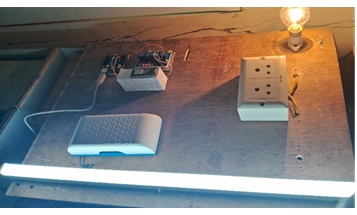Smart Home, It's Vulnerability Assessment Through Penetration Testing

DOI:
https://doi.org/10.54060/a2zjournals.jieee.126Keywords:
Smart home, Penetration Testing, Vulnerability Assessment, Kali LinuxAbstract
Smart home systems, driven by IoT technologies, offer automation and remote control of household devices but also introduce significant security risks. This project develops a smart home prototype using Arduino Uno, ESP32, and relays to simulate common automation features. The goal is to assess system vulnerabilities through penetration testing techniques. Various security weaknesses were identified using Kali Linux tools like Nmap, Wireshark, and Metasploit, including insecure communication and poor authentication. The study highlights the importance of proactive testing and proposes mitigation strategies to enhance smart home security. This research emphasizes the need for integrating cybersecurity practices in smart home development to prevent potential threats and ensure a secure IoT environment.
Downloads
References
N. Raut, S. Samaila Kasimu Ahmad, V. K. Nagarkar, C. S. Satya Prasad, and N. Long, “The Role of Smart Home Tech-nologies in Promoting Sustainable Lifestyles: Marketing Innovations for Eco-Friendly Con-sumer Behavior,” in 2025 First International Conference on Advances in Computer Science, Electrical, Electronics, and Communication Technol-ogies (CE2CT), pp. 873–878, 2025.
B. D. Davis, J. C. Mason, and M. Anwar, “Vulnerability studies and security postures of IoT devices: A smart home case study,” IEEE Internet Things J., vol. 7, no. 10, pp. 10102–10110, 2020, doi: 10.1109/JIOT.2020.2983983.
G. Chu and A. Lisitsa, “Penetration testing for internet of things and its automation,” in 2018 IEEE 20th Interna-tional Conference on High Performance Computing and Communications; IEEE 16th International Conference on Smart City; IEEE 4th International Conference on Data Science and Systems (HPCC/SmartCity/DSS), 2018, doi: 10.1109/HPCC/SmartCity/DSS.2018.00244.
N. Moustafa, B. Turnbull, and K.-K. R. Choo, “Towards automation of vulnerability and exploitation identification in IIoT networks,” in 2018 IEEE International Conference on Industrial Internet (ICII), pp. 139-145, 2018, doi: 10.1109/ICII.2018.00023
A. B. H. Nazarudin, S. Yogarayan, S. F. A. Razak, M. F. A. Abdullah, A. Azman, and D. Kumar, “Comprehensive Re-view of Penetration Testing Approaches on Internet of Things (IoT) Devices,” in 2024 International Conference on Intelligent Cybernetics Technology & Applications (ICICyTA), Bali, Indonesia, pp. 1060–1065, 2024, doi: 10.1109/ICICYTA64807.2024.10913269.
A. Fayoumi, S. Sobati-Moghadam, A. Rajaiyan, C. Oxley, P. F. Montero, and A. Dahmani, “The Cybersecurity Risks of Using Internet of Things (IoT) and Surveys of End-Users and Providers Within the Domiciliary Care Sector,” in 2022 Sixth International Conference on Smart Cities, Internet of Things and Applications (SCIoT), Mashhad, Iran, Islamic Republic, pp. 1–7, 2022, doi: 10.1109/SCIoT56583.2022.9953634.
N. A. Khan, A. Awang, and S. A. A. Karim, “Security in internet of things: A review,” IEEE Access, vol. 10, pp. 104649–104670, 2022, doi: 10.1109/ACCESS.2022.3209355
N. M. Allifah and I. A. Zualkernan, “Ranking security of IoT-based smart home consumer devices,” IEEE Access, vol. 10, pp. 18352–18369, 2022, doi: 10.1109/ACCESS.2022.3148140.
E. Anthi, L. Williams, M. Slowinska, G. Theodorakopoulos, and P. Burnap, “A supervised intrusion detection system for smart home IoT devices,” IEEE Internet Things J., vol. 6, no. 5, pp. 9042–9053, 2019, doi: 10.1109/JIOT.2019.2926365.
A. Chakraborty and A. Kc, “Penetration testing IoT devices to discover critical vulnerabilities,” in 2024 2nd Interna-tional Conference on Recent Advances in Information Technology for Sustainable Development (ICRAIS), Manipal, In-dia, pp. 54–59, 2024, doi: 10.1109/ICRAIS62903.2024.10811719
A. Bazilah Husna Nazarudin, S. Yogarayan, S. F. A. Razak, M. Fikri Azli Abdullah, A. Azman, and D. Kumar, “2024 In-ternational Conference on Intelligent Cybernetics Technology & Applications (ICICyTA),” pp. 1060–1065, 2024.

Downloads
Published
How to Cite
CITATION COUNT
License
Copyright (c) 2025 Kranthi Kondru, Purnima Kancharla, Manikanta Darlanka, Bhuvan Chandu Sathuluri

This work is licensed under a Creative Commons Attribution 4.0 International License.

























